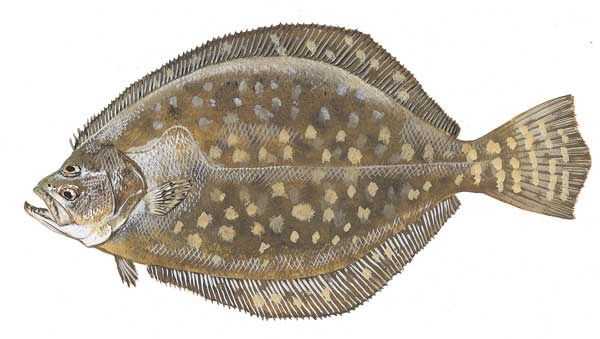Southern Flounder

Species Details
Paralichthys Lethostigma
Paralichthyidae
Pleuronectiformes
Onshore, Inshore, Channels, Rivers
1 - 4 lbs.
12" - 33"
Southern Flounder (Paralichthys lethostigma) Fish Description
A Southern Flounder is a flat, oval fish and is a part of the Paralichthyidae family. It is known for having both of its eyes on the left side of its head. It has an underdeveloped pectoral fin or has none at all. It also does not have any spines on its fins, and its caudal fin is separate.
The Southern Flounder is often mistaken as a Summer Flounder but one of its distinguishing factors among other flounders is its numerous light and dark blotches and spots on their dark side. Other flounders have oscillated spots, which is absent in a Southern Flounder.
It is a known predator, and it ambushes its prey from the bottom, camouflaging itself under sand or mud. It feeds on worms, shrimp, blue crabs, and smaller fishes like anchovies, menhaden, and mullets.
Interesting Facts About Southern Flounder
- A female Southern Flounder can lay up to 9,000 eggs at once.
- It can change its color and mimic the substrate they are in. This helps help hide from predators and also hunt for prey.
- Flounders are anguilliform swimmers. They swim using their bodies and caudal fin.
- Its eyes are both found on one side – also called their ocular side.
- Most Southern Flounders are 'left-handed' (both eyes on the left side), but there are also 'right-handed' Southern Flounders in rare cases.
- A male Southern Flounder's life is shorter than its female counterpart. It can live for at most three years only.
Size
A Southern Flounder typically ranges from 15 to 18 inches and can grow as long as 33 inches. Typically, they weigh around 5 lbs. but it recorded an all-tackle weight of 20 lbs—9 oz.
Habitat and Distribution
The Southern Flounder is found in the waters along the Atlantic seaboard and the Gulf of Mexico. It is commonly found in sandy, rocky, or muddy bottoms of shallow waters of coastal marine areas, bays, rivers, lakes, and estuaries. This makes it easier to catch and feed on prey. Most adult Southern Flounders prefer staying offshore during the winter season.
Southern Flounder - Fishing Techniques
The best technique to catch a Southern Flounder is still fishing or drift fishing since they settle at the water's bottom. Anglers can use live fish and artificial lures as bait. It is best to use a single-hooked, slip lead, or free-line rig with heads ranging from 1/4 "- 3/8". It is advised to use light-to-medium lines with reels that can spool 150 yards per 10 lbs. Anglers can also fly fish using medium lines.
Bull minnows, mullets, and shrimps are the best baits to catch flatfish like flounders.







